2005 VOLVO XC90 tow
[x] Cancel search: towPage 142 of 263

2005 VOLVO XC90
Max. trailer
hitch tongue
load400 lbs
(180 kg)
400 lbs
(180 kg)400 lbs
(180 kg)400 lbs
(180 kg)370 lbs
(165 kg)250 lbs (115
kg)
140 lbs (65 kg)
NOTE:
l Recommended hitch tongue load: not more than 10% of the trailer's weight\
.
The trailer load should be positioned so that it does not shift and the \
tongue load should be 10% of the
trailer's weight. However, the tongue load should not exceed the maximum\
permissible weights
indicated in the table above.
l When towing trailers without brakes, the maximum permissible trailer wei\
ght is 1,700 lbs (750 kg).
l If necessary, redistribute the weight of any cargo in the trailer to avo\
id excessive weight on the trailer
hitch.
l The maximum trailer weight listed in the table for All Wheel Drive model\
s, 5,000 lbs (2250 kg) is
only applicable when there are not more than two occupants in the vehicl\
e, in the front seats, with a
combined weight of 300 lbs (135 kg), with no other cargo in the vehicl\
e.
pg. 106 Starting and driving
Towing a trailer (contd)
l The maximum weight listed for Front Wheel Drive models, 4,000 lbs (1800\
kg) is only applicable
when there are not more than four occupants in the vehicle, in the front\
seats and second row of seats,
with a combined weight of 600 lbs (270 kg), with no other cargo in the\
vehicle.
l Please be aware that the load on the trailer hitch is part of the vehicl\
e's total load carrying capacity.
The amount of cargo in the vehicle and the trailer must be limited so th\
at the gross vehicle weight and
maximum permissible rear axle weight
(see page 165) are not exceeded.
l Vehicles used for towing a trailer on a regular basis, or for long-dista\
nce highway towing should be
equipped with an automatic transmission oil cooler and Volvo's automatic\
self-leveling system for the
rear suspension. Consult your Volvo retailer.
l Volvo recommends the use of Volvo trailer hitches that are specially des\
igned for the vehicle.
l All Volvo models are equipped with energy-absorbing shock-mounted bumper\
s. Trailer hitch
installation should not interfere with the proper operation of this bump\
er system.
l Increase tire pressure to recommended full inflation pressure. See chapt\
er "Wheels and tires."
l When your vehicle is new, avoid towing heavy trailers during the first 6\
20 miles (1,000 km).
l Engine and transmission are subject to increased loads. Therefore, engin\
e coolant temperature should
be closely watched when driving in hot climates or hilly terrain. Use a \
lower gear and turn off the air
conditioner if the temperature gauge needle enters the red range.
l If the automatic transmission begins to overheat, a message will be disp\
layed in the text window.
l Hauling a trailer affects handling, durability, and economy.
l It is necessary to balance trailer brakes with the towing vehicle brakes\
to provide a safe stop (check
and observe state/local regulations).
file:///K|/ownersdocs/2005/2005_XC90/05xc90_06b.htm (12 of 18)12/30/20\
06 4:42:35 PM
Page 143 of 263
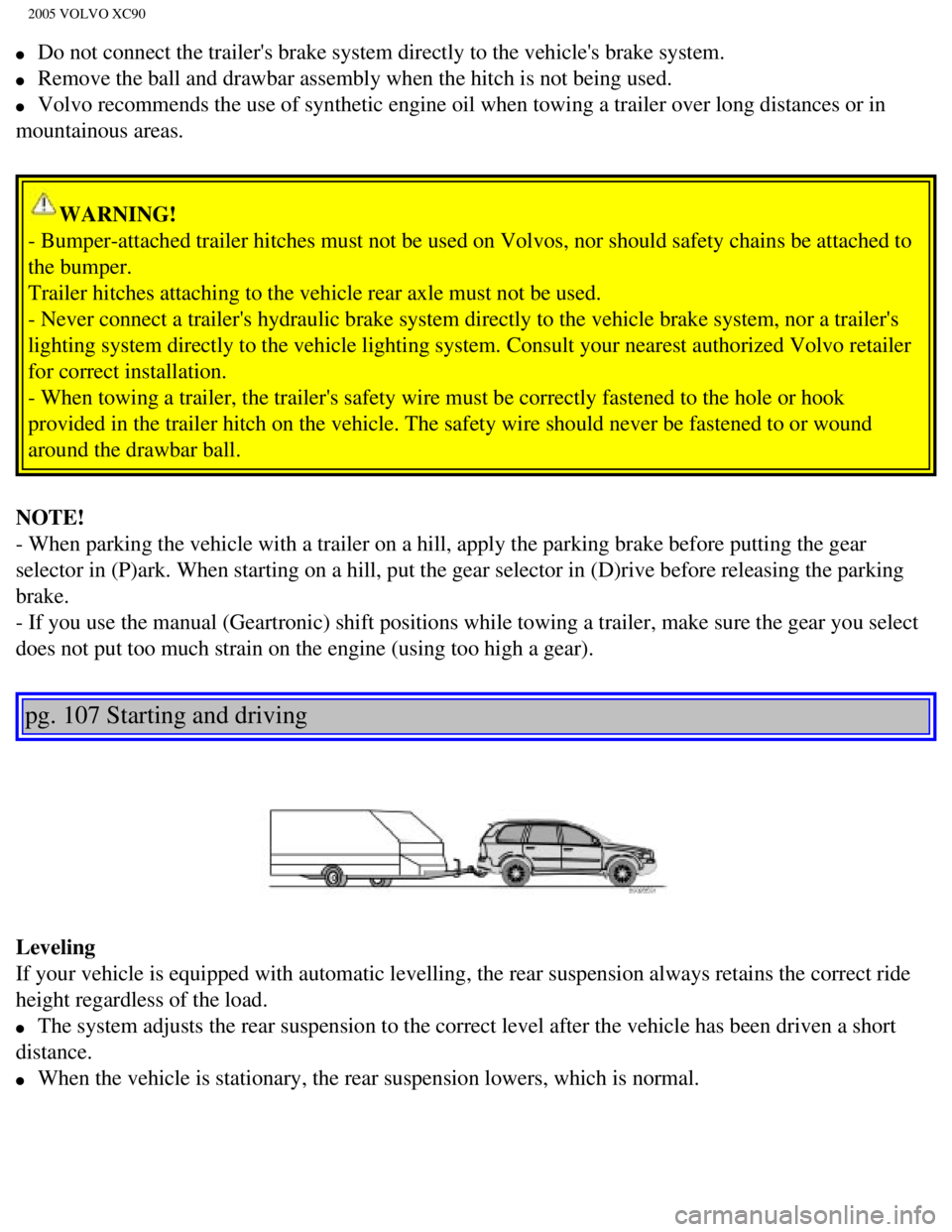
2005 VOLVO XC90
l Do not connect the trailer's brake system directly to the vehicle's brak\
e system.
l Remove the ball and drawbar assembly when the hitch is not being used.
l Volvo recommends the use of synthetic engine oil when towing a trailer o\
ver long distances or in
mountainous areas.
WARNING!
- Bumper-attached trailer hitches must not be used on Volvos, nor should\
safety chains be attached to
the bumper.
Trailer hitches attaching to the vehicle rear axle must not be used.
- Never connect a trailer's hydraulic brake system directly to the vehic\
le brake system, nor a trailer's
lighting system directly to the vehicle lighting system. Consult your ne\
arest authorized Volvo retailer
for correct installation.
- When towing a trailer, the trailer's safety wire must be correctly fas\
tened to the hole or hook
provided in the trailer hitch on the vehicle. The safety wire should nev\
er be fastened to or wound
around the drawbar ball.
NOTE!
- When parking the vehicle with a trailer on a hill, apply the parking b\
rake before putting the gear
selector in (P)ark. When starting on a hill, put the gear selector in \
(D)rive before releasing the parking
brake.
- If you use the manual (Geartronic) shift positions while towing a tr\
ailer, make sure the gear you select
does not put too much strain on the engine (using too high a gear).
pg. 107 Starting and driving
Leveling
If your vehicle is equipped with automatic levelling, the rear suspensio\
n always retains the correct ride
height regardless of the load.
l The system adjusts the rear suspension to the correct level after the ve\
hicle has been driven a short
distance.
l When the vehicle is stationary, the rear suspension lowers, which is nor\
mal.
file:///K|/ownersdocs/2005/2005_XC90/05xc90_06b.htm (13 of 18)12/30/20\
06 4:42:35 PM
Page 150 of 263
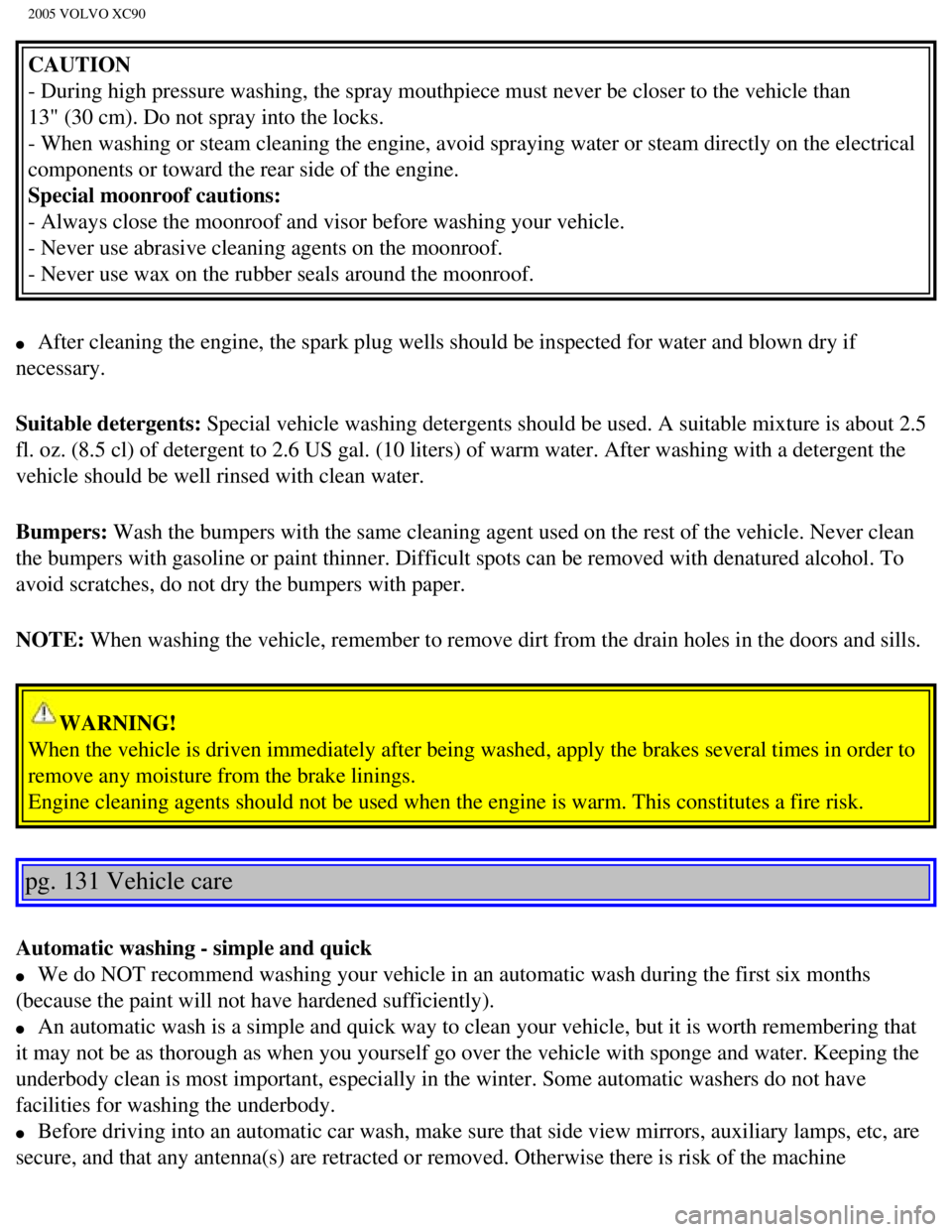
2005 VOLVO XC90
CAUTION
- During high pressure washing, the spray mouthpiece must never be close\
r to the vehicle than
13" (30 cm). Do not spray into the locks.
- When washing or steam cleaning the engine, avoid spraying water or ste\
am directly on the electrical
components or toward the rear side of the engine.
Special moonroof cautions:
- Always close the moonroof and visor before washing your vehicle.
- Never use abrasive cleaning agents on the moonroof.
- Never use wax on the rubber seals around the moonroof.
l After cleaning the engine, the spark plug wells should be inspected for \
water and blown dry if
necessary.
Suitable detergents: Special vehicle washing detergents should be used. A suitable mixture i\
s about 2.5
fl. oz. (8.5 cl) of detergent to 2.6 US gal. (10 liters) of warm wat\
er. After washing with a detergent the
vehicle should be well rinsed with clean water.
Bumpers: Wash the bumpers with the same cleaning agent used on the rest of the v\
ehicle. Never clean
the bumpers with gasoline or paint thinner. Difficult spots can be remov\
ed with denatured alcohol. To
avoid scratches, do not dry the bumpers with paper.
NOTE: When washing the vehicle, remember to remove dirt from the drain holes i\
n the doors and sills.
WARNING!
When the vehicle is driven immediately after being washed, apply the bra\
kes several times in order to
remove any moisture from the brake linings.
Engine cleaning agents should not be used when the engine is warm. This \
constitutes a fire risk.
pg. 131 Vehicle care
Automatic washing - simple and quick
l We do NOT recommend washing your vehicle in an automatic wash during the\
first six months
(because the paint will not have hardened sufficiently).
l An automatic wash is a simple and quick way to clean your vehicle, but i\
t is worth remembering that
it may not be as thorough as when you yourself go over the vehicle with \
sponge and water. Keeping the
underbody clean is most important, especially in the winter. Some automa\
tic washers do not have
facilities for washing the underbody.
l Before driving into an automatic car wash, make sure that side view mirr\
ors, auxiliary lamps, etc, are
secure, and that any antenna(s) are retracted or removed. Otherwise th\
ere is risk of the machine
file:///K|/ownersdocs/2005/2005_XC90/05xc90_07.htm (2 of 6)12/30/2006 \
4:42:36 PM
Page 152 of 263

2005 VOLVO XC90
AlcanteraTM suede-like material
Suede-like upholstery can be cleaned with a soft cloth and mild soap sol\
ution.
Leather care
Volvo's leather upholstery is manufactured with a protectant to repel so\
iling. Over time, sunlight, grease
and dirt can break down the protection. Staining, cracking, scuffing, an\
d fading can result.
Volvo offers an easy-to-use, non-greasy leather care kit formulated to c\
lean and beautify your vehicle's
leather, and to renew the protective qualities of its finish. The cleane\
r removes dirt and oil buildup. The
light cream protectant restores a barrier against soil and sunlight.
Volvo also offers a special leather softener that should be applied afte\
r the cleaner and protectant. It
leaves leather soft and smooth, and reduces friction between leather and\
other finishes in the vehicle.
Volvo recommends cleaning, protecting and conditioning your vehicle's le\
ather two to four times a year.
Ask your Volvo retailer about Leather Care Kit 951 0251 and Leather Soft\
ener 943 7429.
CAUTION:
- Under no circumstances should gasoline, naphtha or similar cleaning ag\
ents be used on the plastic or
the leather since these can cause damage.
- Take extra care when removing stains such as ink or lipstick since the\
coloring can spread.
- Use solvents sparingly. Too much solvent can damage the seat padding. \
- Start from the outside of the stain and work toward the center.
- Sharp objects (e.g. pencils or pens in a pocket) or velcro fasteners\
on clothing may damage the textile
upholstery.
Cleaning the seat belts
Clean only with lukewarm water and a mild soap solution.
Cleaning floor mats
The floor mats should be vacuumed or brushed clean regularly, especially\
during winter when they
should be taken out for drying. Spots on textile mats can be removed wit\
h a mild detergent.
pg. 133 Vehicle care
Paint touch up
file:///K|/ownersdocs/2005/2005_XC90/05xc90_07.htm (4 of 6)12/30/2006 \
4:42:36 PM
Page 164 of 263
![VOLVO XC90 2005 Owners Manual
2005 VOLVO XC90
[43 psi (2.9 bar) for Metric tires]. Increasing the inflation pressure\
beyond this pressure will not increase
the tires load carrying capability.
l kPa: Kilopascal, a metric u VOLVO XC90 2005 Owners Manual
2005 VOLVO XC90
[43 psi (2.9 bar) for Metric tires]. Increasing the inflation pressure\
beyond this pressure will not increase
the tires load carrying capability.
l kPa: Kilopascal, a metric u](/manual-img/45/58559/w960_58559-163.png)
2005 VOLVO XC90
[43 psi (2.9 bar) for Metric tires]. Increasing the inflation pressure\
beyond this pressure will not increase
the tires load carrying capability.
l kPa: Kilopascal, a metric unit of air pressure.
l PSI: Pounds per square inch, a standard unit of air pressure.
l B-pillar: The structural member at the side of the vehicle behind the front door\
.
l Bead area of the tire: Area of the tire next to the rim.
l Sidewall of the tire: Area between the bead area and the tread.
l Tread area of the tire: Area of the perimeter of the tire that contacts the road when mounted \
on the
vehicle.
l Rim: The metal support (wheel) for a tire or a tire and tube assembly upo\
n which the tire beads are
seated.
l Maximum load rating: a figure indicating the maximum load in pounds and kilograms that can \
be
carried by the tire. This rating is established by the tire manufacturer\
.
l Maximum permissible inflation pressure: the greatest amount of air pressure that should ever be
put in the tire. This limit is set by the tire manufacturer.
l Recommended tire inflation pressure: inflation pressure, established by Volvo, which is based on
the type of tires that are mounted on a vehicle at the factory. This inf\
lation pressure is affected by the
number of occupants in the car, the amount of cargo, and the speed at wh\
ich the vehicle will be driven
for a prolonged period. This information can be found on the tire inflat\
ion placard(s) located on the
driver's side B-pillar or on the inside of the fuel filler door on Canad\
ian models, and in the tire inflation
table in this chapter.
l Cold tires: The tires are considered to be cold when they have the same temperatur\
e as the
surrounding (ambient) air. This temperature is normally reached after \
the car has been parked for at least
3 hours.
pg. 120 Wheels and tires
Vehicle loading
Properly loading your vehicle will provide maximum return of vehicle des\
ign performance. Before
loading your vehicle, familiarize yourself with the following terms for \
determining your vehicle's weight
ratings, with or without a trailer, from the vehicle's Federal/Canadian \
Motor Vehicle Safety Standards
(FMVSS/CMVSS) label, and the vehicle's tire information placard:
Curb weight
The weight of the vehicle including a full tank of fuel and all standard\
equipment. It does not include
passengers, cargo, or optional equipment.
Capacity weight
All weight added to the curb weight, including cargo and optional equipm\
ent. When towing, trailer hitch
tongue load is also part of cargo weight.
file:///K|/ownersdocs/2005/2005_XC90/05xc90_08.htm (10 of 17)12/30/200\
6 4:42:37 PM
Page 165 of 263
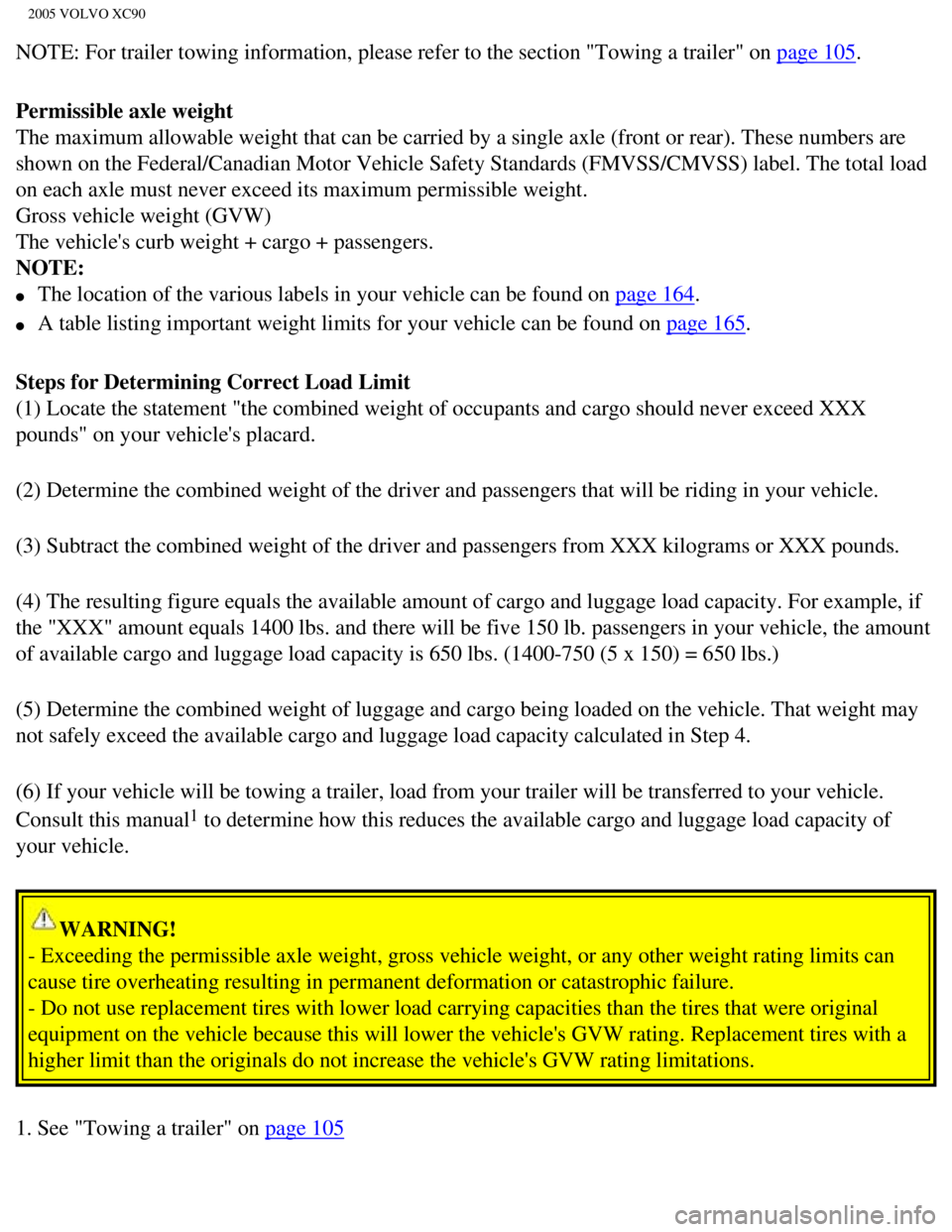
2005 VOLVO XC90
NOTE: For trailer towing information, please refer to the section "Towin\
g a trailer" on page 105.
Permissible axle weight
The maximum allowable weight that can be carried by a single axle (fron\
t or rear). These numbers are
shown on the Federal/Canadian Motor Vehicle Safety Standards (FMVSS/CMV\
SS) label. The total load
on each axle must never exceed its maximum permissible weight.
Gross vehicle weight (GVW)
The vehicle's curb weight + cargo + passengers.
NOTE:
l The location of the various labels in your vehicle can be found on page 164.
l A table listing important weight limits for your vehicle can be found on\
page 165.
Steps for Determining Correct Load Limit
(1) Locate the statement "the combined weight of occupants and cargo s\
hould never exceed XXX
pounds" on your vehicle's placard.
(2) Determine the combined weight of the driver and passengers that wi\
ll be riding in your vehicle.
(3) Subtract the combined weight of the driver and passengers from XXX\
kilograms or XXX pounds.
(4) The resulting figure equals the available amount of cargo and lugg\
age load capacity. For example, if
the "XXX" amount equals 1400 lbs. and there will be five 150 lb. passeng\
ers in your vehicle, the amount
of available cargo and luggage load capacity is 650 lbs. (1400-750 (5 \
x 150) = 650 lbs.)
(5) Determine the combined weight of luggage and cargo being loaded on\
the vehicle. That weight may
not safely exceed the available cargo and luggage load capacity calculat\
ed in Step 4.
(6) If your vehicle will be towing a trailer, load from your trailer w\
ill be transferred to your vehicle.
Consult this manual
1 to determine how this reduces the available cargo and luggage load capa\
city of
your vehicle.
WARNING!
- Exceeding the permissible axle weight, gross vehicle weight, or any ot\
her weight rating limits can
cause tire overheating resulting in permanent deformation or catastrophi\
c failure.
- Do not use replacement tires with lower load carrying capacities than \
the tires that were original
equipment on the vehicle because this will lower the vehicle's GVW ratin\
g. Replacement tires with a
higher limit than the originals do not increase the vehicle's GVW rating\
limitations.
1. See "Towing a trailer" on
page 105
file:///K|/ownersdocs/2005/2005_XC90/05xc90_08.htm (11 of 17)12/30/200\
6 4:42:37 PM
Page 169 of 263
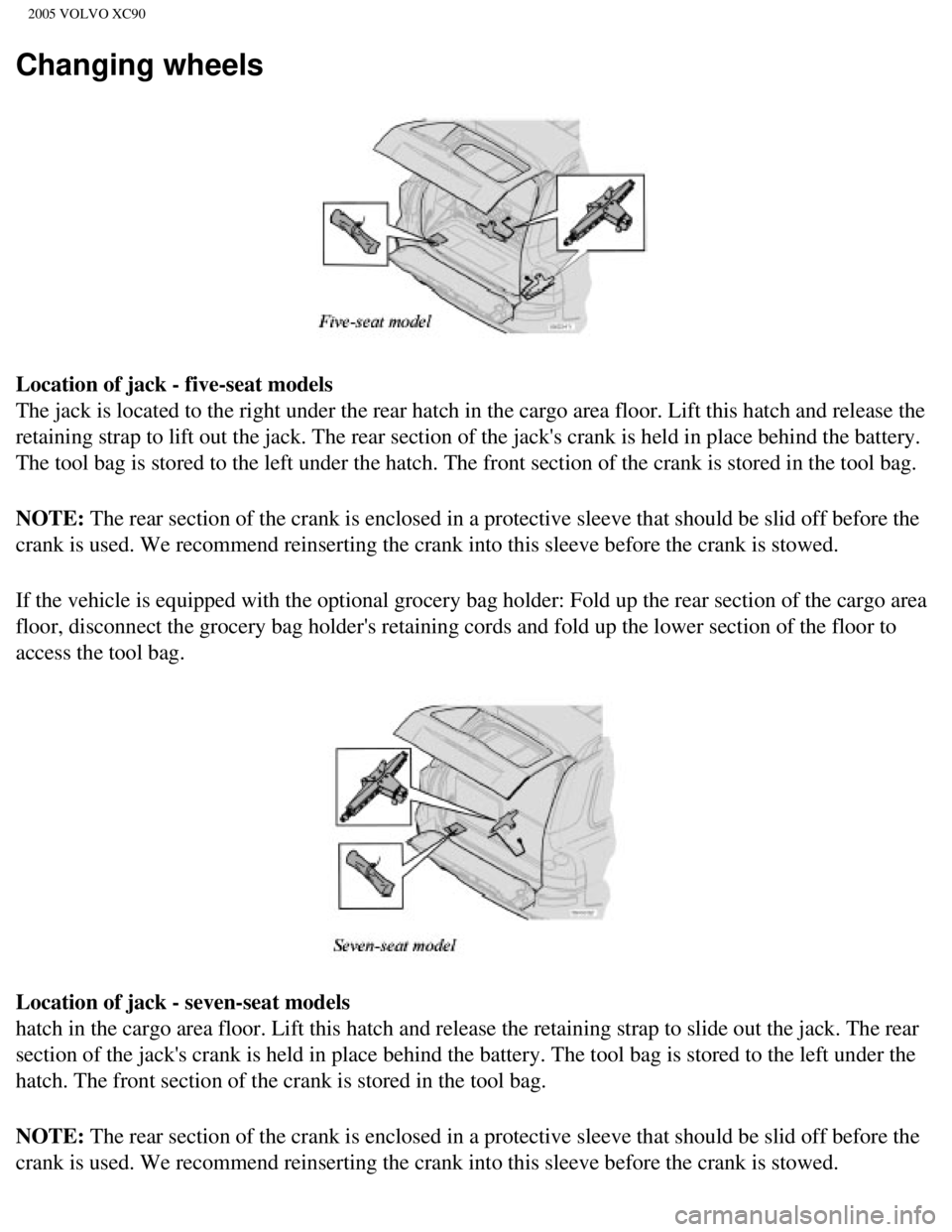
2005 VOLVO XC90
Changing wheels
Location of jack - five-seat models
The jack is located to the right under the rear hatch in the cargo area \
floor. Lift this hatch and release the
retaining strap to lift out the jack. The rear section of the jack's cra\
nk is held in place behind the battery.
The tool bag is stored to the left under the hatch. The front section of\
the crank is stored in the tool bag.
NOTE: The rear section of the crank is enclosed in a protective sleeve that s\
hould be slid off before the
crank is used. We recommend reinserting the crank into this sleeve befor\
e the crank is stowed.
If the vehicle is equipped with the optional grocery bag holder: Fold up\
the rear section of the cargo area
floor, disconnect the grocery bag holder's retaining cords and fold up t\
he lower section of the floor to
access the tool bag.
Location of jack - seven-seat models
hatch in the cargo area floor. Lift this hatch and release the retaining\
strap to slide out the jack. The rear
section of the jack's crank is held in place behind the battery. The too\
l bag is stored to the left under the
hatch. The front section of the crank is stored in the tool bag.
NOTE: The rear section of the crank is enclosed in a protective sleeve that sh\
ould be slid off before the
crank is used. We recommend reinserting the crank into this sleeve befor\
e the crank is stowed.
file:///K|/ownersdocs/2005/2005_XC90/05xc90_08.htm (15 of 17)12/30/200\
6 4:42:37 PM
Page 179 of 263
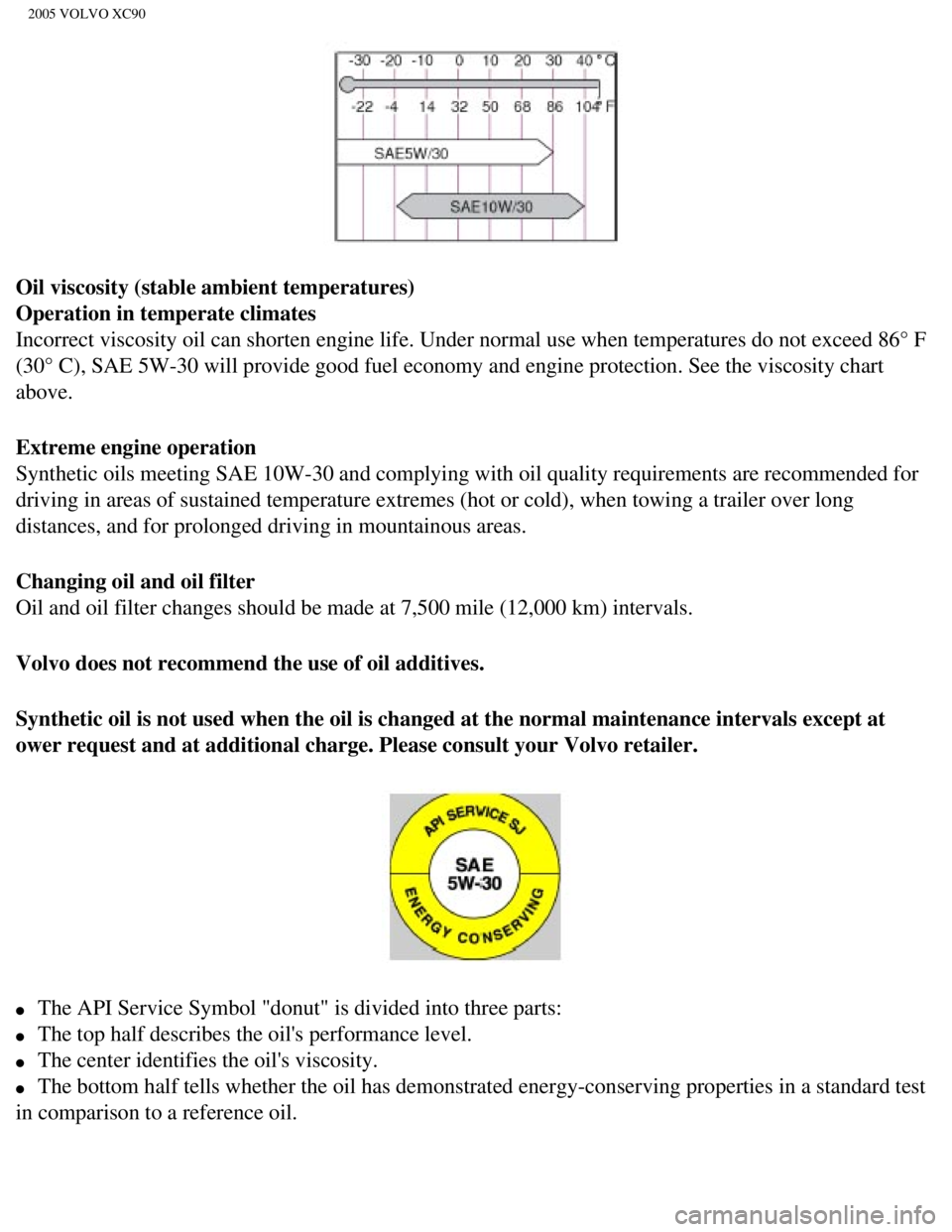
2005 VOLVO XC90
Oil viscosity (stable ambient temperatures)
Operation in temperate climates
Incorrect viscosity oil can shorten engine life. Under normal use when t\
emperatures do not exceed 86° F
(30° C), SAE 5W-30 will provide good fuel economy and engine protec\
tion. See the viscosity chart
above.
Extreme engine operation
Synthetic oils meeting SAE 10W-30 and complying with oil quality require\
ments are recommended for
driving in areas of sustained temperature extremes (hot or cold), when\
towing a trailer over long
distances, and for prolonged driving in mountainous areas.
Changing oil and oil filter
Oil and oil filter changes should be made at 7,500 mile (12,000 km) in\
tervals.
Volvo does not recommend the use of oil additives.
Synthetic oil is not used when the oil is changed at the normal maintena\
nce intervals except at
ower request and at additional charge. Please consult your Volvo retaile\
r.
l The API Service Symbol "donut" is divided into three parts:
l The top half describes the oil's performance level.
l The center identifies the oil's viscosity.
l The bottom half tells whether the oil has demonstrated energy-conserving\
properties in a standard test
in comparison to a reference oil.
file:///K|/ownersdocs/2005/2005_XC90/05xc90_09a.htm (8 of 14)12/30/200\
6 4:42:39 PM